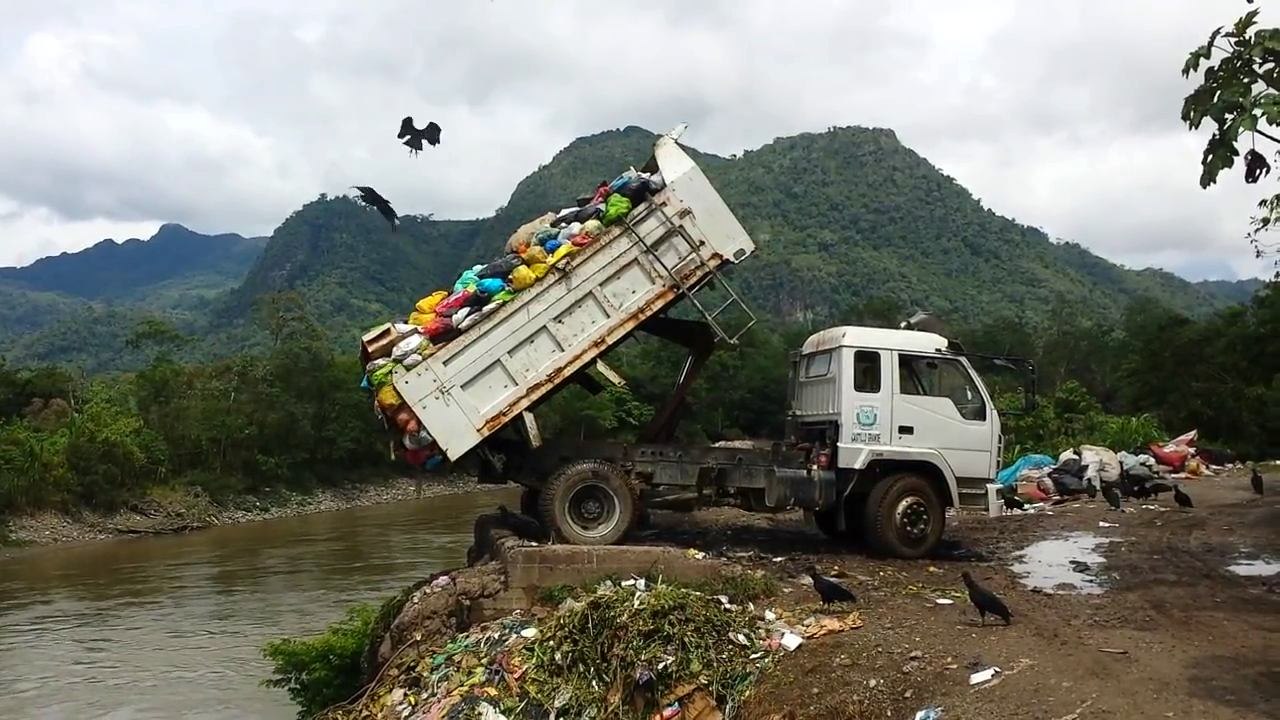Nachhaltiges Abfall- und Kreislaufsystem
- General Challanges
- How do we get rid of the garbage?
- Circular Economy
- What can I do?
- Zero Waste
General Challanges
Planet Earth - Plastic planet?
Waste management is a major problem for our planet. Worldwide we produce 3.5 million tons of daily waste. (1) Germany alone produced 411.5 million tons of waste in 2016 (1). Industrial mass production, increasing consumer behaviour and a lack of solutions for effective recycling exacerbate the waste problem and means that traditional disposal and recycling systems are no longer appropriate.
Waste accumulates as marine litter in the oceans, is distributed over the continents and is crushed by the influence of wind, sun and waves. Plastic waste in particular causes major damage to flora and fauna and reaches the human food chain as microparticles. Since 80 percent of the waste discharged into the sea originates from sources on land, the uncontrolled pollution of waters and seas is predominantly the result of a failed waste management system.

When you think of waste, you often think of the garbage you throw away, the household garbage you can count in kilograms per inhabitant per year. But this is only the visible part of our garbage. For example, for the production of 390 kg of household waste, around 14 tons of industrial and landscape waste is produced, the production ejects Co2 and often uses a lot of precious drinking water. (2)
In 2014, however, household waste accounted for only 8.7% of the waste generated in Europe. 35% came from the construction and demolition industry, 28% was accounted to the mining and quarrying industry. The rest came from the manufacturing industry, water treatment, energy production and others (3).
Plastic is one of the most important and urgent problems. We are drowning in plastic. Meanwhile there are 5 big plastic islands swimming in our seas which have reached the size of Europe. Actually these are strong ocean currents made of plastic parts of different sizes which are deadly for flora and fauna, whether by strangulation danger, microparticles which get into our food or the toxic additives of the plastic which spread in the sea.(4) If it goes on like this, in 2050 there will be more plastic than fish in the oceans (5). This man-made catastrophe is mainly caused by disposable waste. The average life of a plastic bag is 1 second of production time, 20 minutes of use and 400 years of life (6).
How do we get rid of the garbage ?
Waste is often simply stowed on dumps in trenches until it decays. This is no longer the case in Germany, where the focus has been on waste separation and recycling since the nineties, but for example in the border country France, a large part of the waste is buried, incinerated and only an average of 20% is recycled to an average of 80% in Germany (7). This discrepancy comes from the Packaging Ordinance introduced in Germany in 1991, which states that the manufacturer is still responsible for his product after consumption. This led to the development of the "dual system" in Germany, which still ensures that recyclable products are put into circulation and recycled. The government began to invest in education campaigns. Citizens began to separate and return their empties to the point of purchase in exchange for a deposit. The resulting recycling economy was unprecedented in the world (8).
However, 12% of plastic waste worldwide is still incinerated and the heat produced is used as energy. However, the gases emitted are polluting the air and incineration is therefore not a sustainable solution for plastics or for disposing of waste in general (9).

Recycling is another way to process our waste more sustainably. There are three forms of recycling. Recycling describes the general reprocessing of a used or defective object or material. Downcycling is the processing of an object for reuse with low energy costs and little or no new added material which is desirable in itself. But this often means a loss of product quality every time it is recycled, making it impossible to recycle the product indefinitely. Therefore there is the possibility of upcycling. Here a new material is added in the recycling of the starting product so that the end product is of higher quality than the starting product. Unfortunately this process is more energy consuming and therefore not as environmentally friendly as Downcycling (10).
Let's name nuclear waste, which does not represent the largest part of the waste produced, but which poses the most problems.
How do we get rid of nuclear waste ? The most common solution so far is to bury it. But since part of this waste will still be radioactive in 10,000 years, scientists today, are wondering how to make it clear to people in the future that it is better, not to build wells at the radioactive graves...
Circular Economy
What is the circular economy?
Taking as an example the cyclical nature pattern, circular economy is presented as a system of resources utilization where reduction, reuse and recycling of elements prevails: minimize production to a bare minimum, and when it's necessary to use the product, go for the reuse of the elements that can not return to the environment.(11)
One problem is to remove or reuse the existing waste, the other is not to produce any more waste. Our waste management is largely linear, which means that the remains of a product know little or no reuse (disposable products), so they become useless and further waste. Even recycled products are not infinitely recyclable. Switching to a circular economy would reduce unnecessary waste and ultimately eliminate waste as a concept. Moreover, nature itself is a circular economy, which finds a specific purpose for every remnant, whether animal or plant.
In 2018, the European Union revised its waste management guidelines to approach a circular system, for example by tightening waste prevention, separate waste for better recycling, higher expected recycling rates and producer responsibility (12). But despite these directives, in Europe we are still a long way from a complete recycling economy.
Well, a complete recycling economy would be a change for the whole society. From the production, over the consumer up to the disposal which should rather be called a collection for re-use.
Unfortunately, it is even more difficult for emerging and developing countries to develop and change their waste management. In the developed countries, however, it is quite possible to do justice to this change, but it requires the deployment of all our forces. The changeover also begins with us, the consumers.
As an individual consumer, it is of course difficult to intervene in industrial waste disposal, but you can be careful not to produce so much waste yourself.
A first step is to consume differently, to consume more consciously. For example, you can use a reusable bag for shopping, don't pack fruit and vegetables in disposable plastic bags, prefer products with less packaging or even go to the unpacked shop, use a thermo cup for your coffee to go, use reusable bottles, etc.
There are endless tricks how to easily and efficiently reduce your garbage. The most important thing in everyday life is to avoid plastic waste. Keep in mind that we are not at the end of the decision-making chain, but at the centre. Production will adapt to our consumer behaviour. Of course, this will not happen from now on, but there are many examples that shows a development towards waste reduction and therefore sustainability. The sale of shopping bags, and above all the offer of reusable bags; the introduction of paper bags instead of plastic for fruit and vegetables; the opening of more and more unpacked shops shows us that we are the trigger of change.
More and more people try not to produce any garbage at all, in everyday life. Not easy to imagine in our society nowadays. But there are many examples and interviews of people who made it. At the end it is even more cost-efficient and healthier. Often you have to change your consumer behaviour, but we think that a change in today's consumer behaviour is desirable. Of course it is difficult not to produce any garbage at all overnight, but if you pay attention and look for alternative solutions, the change comes step by step.
Start by looking where you can avoid waste production in your everyday life and what alternative you can find for it.
How can you avoid unnecessary waste when buying your products? Inform yourself, inspire yourself.
Sei du selbst die Veränderung!
Schließe dich der kollektiver Bewegung an
(Füge ein Projekt hinzu, welches du inspirierend findest)

